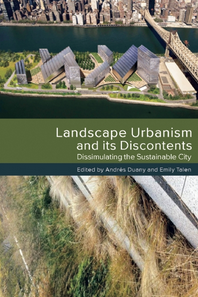(Our friend Neal Payton sent along the exciting news that an essay he wrote, The Metropolis Versus the City, appears in the new book Landscape Urbanism and Its Discontents. Payton provided an excerpt from the essay to whet our appetites for the entire book.)
Proponents of Landscape Urbanism view post-war planning as a product of the forces of technological and economic modernity — characterized by mass communication, personalized transport, and decentralized manufacturing, which necessitate vast logistical networks for warehousing, distribution, and sales. In their eyes, the evolution of postwar planning parallels a timeline in which the corner store is supplanted by the supermarket and the latter by the warehouse club. As a result, Landscape Urbanists propose new, and more open-ended urban paradigms. They tend to promote urban or metropolitan morphologies that lack spatial definition and even celebrate automobility.
Landscape Urbanists make the case for an urbanism that is vehicular in its scale yet fundamentally guided by a commitment to environmental restoration. These founding theorists aim at expanding the scope and efficacy of landscape beyond any given site or program, beyond even such urban spatial typologies as parks and streets. In both an homage to the decentralizing forces of natural systems as well as sixty years of postwar sprawl, Landscape Urbanism seems intent on diluting the fundamental distinction between city and country. In other words, from a human settlement point of view, it embraces the Metropolis with its boundlessness and corresponding speed of movement, rather than the City with its spatial limits and diversity of pace.
New Urbanists consider the past two generations of planning as an aberration, representing something of a self-imposed collective amnesia rather than a permanent change to the cultural episteme. Rather than representing the forces of modernity, they view the past half-century of planning in terms of the dominating influence of Euclidean zoning and traffic engineering, nothing more culturally significant than that. In fact, they would argue, traditional, pre-war urbanism has proven to be far more resilient in the marketplace than any other model precisely because of its continued cultural relevance. In contrast to Landscape Urbanism, they argue for an urbanism that is spatially and temporally defined.
New Urbanists make the case that pedestrian-scaled urbanism can help restore a sense of community. In both its opposition to the decentralizing forces of postwar sprawl and its recognition of the problems emanating from real estate development practices, New Urbanism aims to restore the fundamental distinction between city and country. This translates to an explicit embrace of a distinct typology that recognizes the neighborhood, the town, and, most significantly, the City.
Viewed according to this dichotomy, the words “metropolis” and “city” are not used here simply as terms denoting different scales of urban habitation. The term “metropolis” is not meant to connote an excessively large and sprawling urban mass, nor even a collection of cities and suburbs. Rather the Metropolis and the City represent different speeds of habitation, where different sizes and scales of urbanism are utilized. While the City is composed of neighborhoods defined in size by the pace of a pedestrian, bound together by corridors — the Metropolis is characterized as much by the corridors themselves, i.e., the green, grey, or brown swaths of land that connect neighborhoods and districts to one another, defined more by the pace of the automobile.
Neal Payton is a Principal with the architecture firm Torti Gallas and Partners, Inc, which has taken the lead on many progressive developments not limited to one of Damien's favorite all-time Park(ing) Day spaces.







